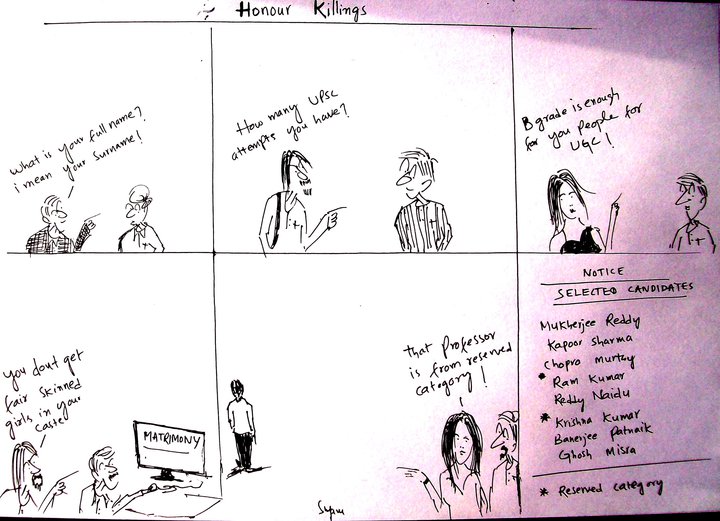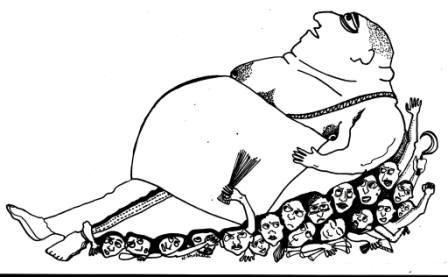Shakyamuni Chandal
 A veritable danger lurks over the whole corpus of knowledge and practices developed as a result of Dalit existence, assertion and its resistance to Brahminism; in short, the entire Dalit episteme: from the teachings of Buddha, Ajiwakas, Siddhas, Naths, Bauls, south Indian revolutionaries like Akkamahadevi, Basavanna, Chenna Basavanna, Kinnari Bommayya, Siddharama, Allamaprabhu and Dasimayya (all incorrectly christened as Bhaktas) to Kabir, Nanak, Bulle Shah among many others. And this threat is directed at their histories too. Such appropriation however is nothing new. It has been a common feature throughout history. Only the methods that are deployed find novel ways (most recently novelists’ ways too).
A veritable danger lurks over the whole corpus of knowledge and practices developed as a result of Dalit existence, assertion and its resistance to Brahminism; in short, the entire Dalit episteme: from the teachings of Buddha, Ajiwakas, Siddhas, Naths, Bauls, south Indian revolutionaries like Akkamahadevi, Basavanna, Chenna Basavanna, Kinnari Bommayya, Siddharama, Allamaprabhu and Dasimayya (all incorrectly christened as Bhaktas) to Kabir, Nanak, Bulle Shah among many others. And this threat is directed at their histories too. Such appropriation however is nothing new. It has been a common feature throughout history. Only the methods that are deployed find novel ways (most recently novelists’ ways too).
The AA Battery
The machine of such blatant appropriation has recently been energized and powered by a certain double A battery (AA- Arundhati Roy and Anand Iyengar) of Brahmeans (according to me the right nomenclature for a Brahmin, signifying a key Brahmanic quality, meanness, which according to Dr. Ambedkar is worse than cruelty). With their latest joint venture of bringing out ‘A Critical and Annotated Edition’ of Babasaheb’s ‘Annihilation of Caste (AoC)’, they carry forward the age-old tradition of Brahmins exploiting Dalit labour and culture.
It was the same machine that rendered Kabir toothless in the past. The act started with the very categorisation of what Kabir’s life and words meant: what should have been called a revolt was wrongly and cunningly termed as Bhakti i.e. surrender. Kabir was mutilated by a Hindi-chauvinist Brahmin organisation, which was formed for Brahminising Hindi- interpolating it with, and ”purifying” it, by sprinkling the Gangajal called Sanskrit on it. This happened in the 1890s under the leadership of a Punjabi Khatri, Babu Shyam Sundar Das, and a reactionary Brahmin, Ramchandra Shukla. To see how far their appropriation and distortion was institutionalized one must consider the fact that the Hindi-English Dictionary1 edited by the duo is accepted by American universities and the Government of India as standard and authoritative.
This sort of usurpation goes hand in hand with the stifling of alternative meanings and hence makes any other interpretations (other than the appropriated versions) impossible. In the above mentioned case, for example, Dalit Hindi (a language that found voice among the lower caste viz. Ahirs – its old name was Ahiri Bhasha) or any other version of Hindi, was either erased or made impossible to continue. In a similar manner, the canonization and distortion of Kabir (the mutilated Kabir) disallowed any alternative reading. For example, they had substituted ‘sunna’ and ‘shabda’ with ‘Rama’ in the renditions of Kabir. This has been pointed out by Sadafal Guru, a Saint belonging to the Kabiric tradition, in his book ‘Swarwed’.
The introduction of ‘Rama’, a strong and problematic Hindu symbol, into this tradition was very dangerous. This was tantamount to Brahminisation of Kabir. Furthermore, the very tradition of Sadafal Guru has been appropriated by his son and a certain Swantantra Dev ji Maharaj who organised hawanas and chanting of Vedas in the name of Kabir. How shocking to know that Kabir who was vehemently against Vedas and their nasty teachings was made a vehicle for propagating Vedic Karmakanda (rituals)! The Kabir Project of Linda Hess is also a product of the same ugy machine of appropriation. They all want to reduce Kabir to meaningless metaphysics.
The mutilated Kabir edited by the Punjabi Khatri, Babu Shyam Sundar Das, is prescribed in the syllabus of Hindi Literature in Civil Services exams conducted by UPSC. This was the clever tactic by which the monopoly of ‘revised’ ‘Brahminised’ texts, through which Brahmins inflict and maintain hegemony over entire knowledge systems, was ensured beyond any doubt. Would this also be the fate of Babasaheb’s AoC as already pointed out in an earlier essay on Round Table India2?

Taking further the example of Kabir, we must bear in mind that he was a revolutionary poet. The tampering and appropriation of his works transformed him into a spineless creature: a Bhakta (devotee). The Brahminist forces falsely reduced him to someone contemplating vacuous and obtuse rubbish on Brahma. The social resistance and struggle offered by the poet-revolutionary was erased from the collective memory of his caste peers and it was thus absent in the narratives of even Dalit history. This is a harsh reality to face because when we Dalits try to reconstruct our own splintered history, our sources are often those managed, controlled and distorted by the Brahmins. Other sources of history are deliberately erased. They make it impossible to reclaim Dalit history by creating a certain mythology around the Dalit personality. A total closure of history is effected by them through this mythologizing and ‘fixation’ of meaning. Text is no more the infinite play of meaning in the Brahminised world. Apart from that they play around with the narrative too. For example they made a prince out of Buddha who was otherwise a citizen of the republic of Shakyas. Or they made Kabir the illicit son of a Brahmin ”saint” (not doctor?) Ramananda while in fact Kabir was the son of lower caste parents- Niru and Nima.
The Machine of Hypocrisy
True to their hegemonizing and controlling tactics they continue the shameless use of this machine with renewed force and vigour well into the 21st century. And they do it under the garb of being ‘progressive’, ‘liberal’, or standing for ‘freedom of expression’ and other such dubious notions. This context goads a Dalit like me to examine the devilish design of the AA battery by placing a speculum into their acts of appropriation. The battery’s evil motives of appropriating the Dalit movement is typically Gandhian in theme as illustrated by several others in the various articles on Round Table India. In this connection it is not misplaced to recall the hypocrisy of the arrogant Arundhati Roy (hereafter referred to as AR). AR declined the offer to make her debut (and only) novel, The God Of Small Things, into a film citing her reservations against the danger of ‘fixing’ the meaning etc., in the cinematic interpretation of the story. The same AR, however, is ruthless and adamant on ‘fixing’ the meanings of AoC through so-called critical ‘annotations’ and creating a hyper-reality by mapping AoC into a preface longer than the book itself. It is like making a map of Puducherry3 which is bigger in area than Puducherry itself. One would wonder how is that a problem? First of all, this map which involves magnifying the text and its meanings is ‘justified’ by them under the dubious pretext of making it ‘visible’ (touchable? cf. commentary named ‘Touchable Tales’ by Navayana) to the elite Hindu-Brahmin and white audiences. But actually this misdemeanour not only reduces AoC but also severely disfigures it, destroys its totality.
In fact, it litters AoC with the meaningless clutter of metaphysical pixels in the form of obnoxious Arundhatian observations. You are lost in the map if you are not a Brahmin. The map becomes more ‘real’ than Puducherry. Thus it puts the real Puducherry in abeyance and imposes a hyper-real Baudrillardian map in its place. Noteworthy is also the timing of such an act (as pointed out by U. Sambashiva Rao in his intervention featured in RTI4) since it seeks to mutilate both space and time, that is, both the Dalit identity and history. It is a typical Brahminist project vis-a-vis the ‘project of silences’ which she mentions repeatedly in her preface. One must actually call it a ‘de-face’ –a defacing of Babasaheb and his politics. She attempts to render Babasaheb inaudible not by silencing him or through what she calls the ‘project of silence’ but through drowning it in a deliberate and harmful cacophony – the cacophony of a 180 page long preface that I prefer to call a ‘de-face’.
The Ghost of Capitalism
AR deforms Babasaheb in brutal and different ways – a practice seen to be a favourite sport of the savarnas as evidenced by the plight of many statues of his. Her strategy is multi-pronged. On the one hand she commodifies Dalit resistance (she has a habit of com-modifying other resistances too, viz. Adivasi resistance). She makes it easily consumable in the Brahmin market by making it akin to an exotic zoo animal to be sold to her elite occidental and Brahmin audience. On the other hand, she greedily strives to occupy the space where Dalit resistance is situated, thus denying Dalits any room to articulate their struggle against Brahminism. Her strategy is aimed at controlling Dalit resistance and in this controlling to contain it.
She reincarnates herself into a Gandhi. She morphs some Dalits into Jagjivan Rams (much like Gandhi did) and gets these Jagjivans to applaud, award and defend her. To draw here a parallel from popular culture one is reminded of the recent Spiderman movie. One gets the impression that AR attempts to create robots out of the oppressed Dalits who work for her (this is another matter that these robots/machines get out of control of the villain at times!).
She makes some Dalits into her ‘small things’—things of study, things of pity, things of examination, things of critical scrutiny, things of defence, things of Gandhism. She seeks to be a Delphi-Goddess of ‘small things’ for plebeians along with patricians who awarded her their Booker. One is compelled to refer here to Babasaheb mentioning the Delphi-Goddess in AoC to gauge what this Goddess means for Brahmins/Patricians and to see how crucial she is to the reinforcement and perpetuation of Brahminism.
The two-faced colonizer

At another level she behaves like a colonizer. This colonizer is two-faced. It (I use ‘it’ for the colonizer since I consider them dehumanizing and inhuman) is a regular colonizer who has to conquer land and nature, much like Robinson Crusoe. It is also the ‘orientalist’ colonizer out there on its modernist project of a ‘will to know’ and in such knowing to mythify the colonized and shut its mouth. Which is followed by the ludicrous and insulting question in postmodern Brahmin-ese spoken through its Gayatri Spivak avatar – Can the subaltern speak? AR assumes both these roles of the colonizer. Dalit intellectual space is the land – Puducherry Land – which she seeks to colonize. A colony, as one knows, is considered to be a source of raw materials as well as a market for finished goods. For the imperialist machine powered by the AA battery, the AoC is envisaged as raw material which needs to be processed and is in constant want of ‘refinement’. The finished product is the ‘annotated’ (read mutilated: now it has become what it is not in Fanonian terms) AoC to be consumed by a new middle class of small castes and the big middle class of big castes. And of course finished goods prepared from the colony are exported too as we might witness soon enough.
The Focauldian ‘other Gandhi’
This bid for appropriation of Ambedkar is further development of similar projects (though failed ones) by the Jat-Pat Todak Mandal and Gandhi. What was left unfinished by Gandhi is carried forward by the AA battery through certain advanced mechanisms. AR is in fact a modernised Gandhi. She is modern, and hence revels in this display of a love-hate relationship with Gandhi. Much like Nehru who, we are made to believe, was allegedly modern. Therefore any person who wants to further the cause of Gandhi, which is, to produce and reproduce Brahminism to oppress smaller castes, is bound to enter into such a covalent relationship with Gandhi. AR is no exception.
The production and reproduction of Brahminism is a crucial and much needed area to be explored, exposed and demolished. This essay of mine is just a small attempt to point towards that direction. By production of Brahminism, I mean its development, sustenance, reproduction and perpetuation. Despite the false claims around cultural studies, the production in the culture industry in India, which is usurped and managed by the Brahmin, has been left unanalysed. One sees that even in how they have dubbed any Dalit resistance (even the one to this latest AA project) into Identity politics, while they cleverly refuse to see any identity politics in how the savarnas hold on to their positions of power in media, academia, publishing etc. Not only is the Brahmin politics made clandestine by dint of this hegemony over knowledge but the very Brahmin hegemony over production and reproduction of knowledge and knowledge systems is intentionally obscured. I draw on the notion developed by Louis Althusser and Walter Benjamin and their suitable adaptation to the Indian context to bring about a clear perspective of inner weavings of hegemonic relations within and without Brahminism.
When AR assumes the role of Gandhi in oppressing the Dalit episteme, it is part of the same reproduction of Brahminism. When this role is expanded and consolidated by the likes of Kancha Ilaiah, I call it production. Thus production and reproduction are bound in dialectical unity. Production introduces new elements into Brahminism and reproduction perpetuates it. Brahminism is produced through agents but reproduced through Brahmins themselves. Reproducers choose production agents from the oppressed community itself. They are vectors of Brahminism. The anti-Brahminism struggle is conveniently targeted against these agents- the producers of Brahminism, and ends up being successful. Yet, Brahminism continues to thrive because the reproducers are not challenged and targeted in this struggle. Babasaheb’s unique contribution to the caste struggle was targeting the reproducers, that is, the Brahmins. The Jat-Pat-Todak Mandal and Gandhi realised this and so they vehemently opposed him. So much so that the former published Babasaheb’s reply and the write-up without his permission. Gandhi ridiculed Babasaheb and recognised him as his real enemy. He mentioned tauntingly that Babasaheb had wanted ”not to be forgotten”. We, from lower castes, understand full well what the exact intention of Babasaheb was and what he wanted. And indeed we want him never to be forgotten, never to be erased from history, not to be mutilated, ‘de-faced’, mythified, reified or roy-fied.
AR as a Brahmin is the current leader of this project of appropriation of Dr Ambedkar. She, as explained above, is reproducing and perpetuating Brahminsim. This act has already been challenged and will have to be demolished. Paulo Freire envisaged history as possibility. But history can be thought of as impossibility too. Make this history of repeated appropriation impossible. Mythify the myth. Erase AR from Dalit history. Stop the reproduction of the ‘other’ Gandhi into ARs. To conclude I find this couplet from Kabir Saheb quite fitting:
Ham na marihaun, marihe sansara
(I will not vanish; this world (of Brahmin) will be annihilated instead).
~
Notes
[1]. http://dsal.uchicago.edu/dictionaries/dasa-hindi/
[2]. Essay by James Michael and Akshay Pathak in RTI , http://roundtableindia.co.in/index.php?option=com_content&view=article&id=7309%3Aa-glass-menagerie-for-the-bahujans-annihilation-of-caste-and-gandhi-s-wards&catid=119%3Afeature&Itemid=132
[3]. Puducherry is a small city and union territory which was colonized by the French in the past. The notion of hyper-reality is attributed to Jean Baudrillard, a French thinker . The choice of Puducherry as an illustration is a conscious one considering similarities between the power techniques of the French and the Brahmins. They achieve the best economy of power and ensure political exclusion by social inclusion and vice versa and do not accord both at a given time. They suppress by exclusion contrary to British who adopt inclusive methods of regimentation or colonisation to be more precise. Therefore French colonies are not colonies in the true sense of the word: they are appropriations.
~
Please also read other articles on the same issue:
Arundhati Roy’s introduction to AoC is a tactical, brahminical trick
~
On how Arundhati Roy introduces AoC without losing her upper hand: by Murali Shanmugavelan
~
Introducing Arundhati Roy and Friends: by Karthik Navayan
~
A tale of two prefaces: by Karthick RM
~
Between Savior and Seller: Critiquing Preface Politics: by Praveena Thaali
~
A Glass Menagerie for the Bahujans—Annihilation of Caste and Gandhi’s Wards: by James Michael and Akshay Pathak
~
Stigmatizing Dalits, From the Wadas to the Web: by Nilesh Kumar
~
Without Arundhati Roy and Gandhi, the book had its own value: Bojja Tharakam
~
Caste in the Name of Christ: An angry note on the Syrian Christian Caste: by Nidhin Shobhana
~
The Not-So-Intimate Enemy: The Loss and Erasure of the Self Under Casteism: by Gee Imaan Semmalar
~
Flaunting noble intentions, nurturing caste privileges: by Asha Kowtal
~
The Question of Free Speech: by Vaibhav Wasnik
~
Arundhati Roy replies to Dalit Camera
~
An open letter to Arundhati Roy: by Dalit Camera
~
Vedic Chants for the 21st Century
~
Arundhati Roy’s “Introduction’ to Ambedkar: Inside one Misogynistic & Xenophobic Dalit’s mind: by Anoop Kumar
~
The Judge, the Jury and the Goddess: by Akshay Pathak
~
Resisting a Messiah : by Anoop Kumar
~
An Introduction to Anoop Kumar’s “Misogynistic and Xenophobic Rants”: by Vinay Bhat
~~~
Shakyamuni Chandal is a medical doctor practising in Ranchi, Jharkhand. His interests include reading Periyar and Ambedkar.
Images Courtesy: The South Asian (for the Kabir image) and Ressources Pour Le College (for the Robinson Crusoe image)










